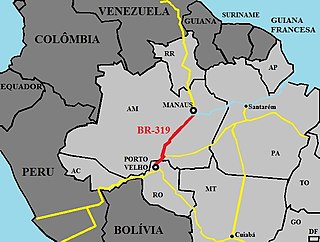
The Muras are an indigenous people who live in the central and eastern parts of Amazonas, Brazil, along the Amazon river from the Madeira to the Purus. They played an important part in Brazilian history during colonial times and were known for their quiet determination and subsequent resistance to the encroaching Portuguese culture. Formerly a powerful people, they were defeated by their neighbors, the Munduruku, in 1788.

Beruri is a municipality located in the Brazilian state of Amazonas. Its population was 20,093 (2020) and its area is 17,251 km².

Borba is a municipality in the state of Amazonas in northern Brazil.
The Matupiri River is a river of Amazonas state in north-western Brazil. It is a tributary of the Igapó-Açu River.
Nascentes do Lago Jari National Park is a national park in the state of Amazonas, Brazil. It protects an area of Amazon rainforest in the BR-319 highway area of influence.
The Jari River is a river in the state of Amazonas, Brazil, a tributary of the Purus River.

The Amazon Region Protected Areas Program is a joint initiative sponsored by government and non-government agencies to expand protection of the Amazon rainforest in Brazil.
Piagaçu-Purus Sustainable Development Reserve is a sustainable development reserve in the state of Amazonas, Brazil.
The Lago do Capanã Grande Extractive Reserve is an extractive reserve in the state of Amazonas.
The Amapá River is a river of the state of Amazonas, Brazil. It is a tributary of the Matupiri River.

The Ituxi Extractive Reserve is an extractive reserve in the state of Amazonas, Brazil.
The Matupiri Sustainable Development Reserve is a sustainable development reserve in the state of Amazonas, Brazil.
The Rio Madeira Sustainable Development Reserve is a sustainable development reserve in the state of Amazonas, Brazil.
The Rio Amapá Sustainable Development Reserve (Portuguese: Reserva de Desenvolvimento Sustentável do Rio Amapá is a sustainable development reserve in the state of Amazonas, Brazil.
The Igapó-Açu Sustainable Development Reserve is a sustainable development reserve in the state of Amazonas, Brazil. It is part of a "green barrier" created to prevent deforestation along the BR-319 highway.
The Canutama Extractive Reserve is an extractive reserve in the state of Amazonas, Brazil.
The Canutama State Forest is a state forest in the state of Amazonas, Brazil.
The Tapauá State Forest is a state forest in the state of Amazonas, Brazil.

BR-319 is an 870-kilometre (540 mi) federal highway that links Manaus, Amazonas to Porto Velho, Rondônia. The highway runs through a pristine part of the Amazon rainforest. It was opened by the military government in 1973 but soon deteriorated, and by 1988 was impassable. In 2008 work began to repair the highway, which will provide an alternative to boat travel along the Madeira River or flying between Manaus and Porto Velho. Protected areas have been created along the route in an effort to prevent deforestation when BR-319 is reopened, a serious concern given the devastation caused elsewhere by highways such as BR-364. As of mid-2016 paving of the middle section of the highway had yet to be approved. Construction permits will depend on measures to prevent future damage to the forest.







